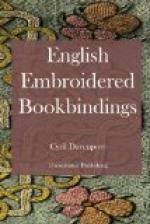’The freehand drawing of our artists under the Anglo-Saxon kings was incomparably superior to the dead copies from Byzantine models which were in favour abroad. The artistic instinct was not destroyed, but rather strengthened, by the incoming of Norman influence; and of the twelfth and thirteenth centuries there is abundant material to show that English book-decoration was then at least equal to that of neighbouring countries. For our art of the early fourteenth century we claim a still higher position, and contend that no other nation could at that time produce such graceful drawing. Certainly inferior to this high standard of drawing was the work of the latter part of that century; but still, as we have seen, in the miniatures of this time we have examples of a rising school of painting which bid fair to attain to a high standard of excellence, and which only failed for political causes.’[1]
To this judicial pronouncement on the excellence of English manuscripts on their decorative side, we may fairly add the fact that manuscripts of literary importance begin at an earlier date in England than in any other country, and that the Cotton MS. of Beowulf and the miscellanies which go by the names of the Exeter Book and the Vercelli Book have no contemporary parallels in the rest of Europe.
[Footnote 1: English Illuminated Manuscripts. By Sir Edward Maunde Thompson, K. C. B. (Kegan Paul, 1895), pp. 66, 67.]
When we turn from books, printed or in manuscript, to their possessors, it is only just to begin with a compliment to our neighbours across the Channel. No English bookman holds the unique position of Jean Grolier, and ‘les femmes bibliophiles’ of England have been few and undistinguished compared with those of France. Grolier, however, and his fair imitators, as a rule, bought only the books of their own day, giving them distinction by the handsome liveries which they made them don. Our English collectors have more often been of the omnivorous type, and though Lords Lumley and Arundel in the sixteenth century cannot, even when their forces are joined, stand up against De Thou, in Sir Robert Cotton, Harley, Thomas Rawlinson, Lord Spencer, Heber, Grenville, and Sir Thomas Phillips (and the list might be doubled without much relaxation of the standard), we have a succession of English collectors to whom it would be difficult to produce foreign counterparts. Round these dii majores have clustered innumerable demigods of the book-market, and certainly in no other country has collecting been as widely diffused, and pursued with so much zest, as in England during the present century. It is to be regretted that so few English collectors have cared to leave their marks of ownership on the books they have taken so much pleasure in bringing together. Michael Wodhull was a model in this respect, for his book-stamp is one of the most pleasing of English origin, and his




